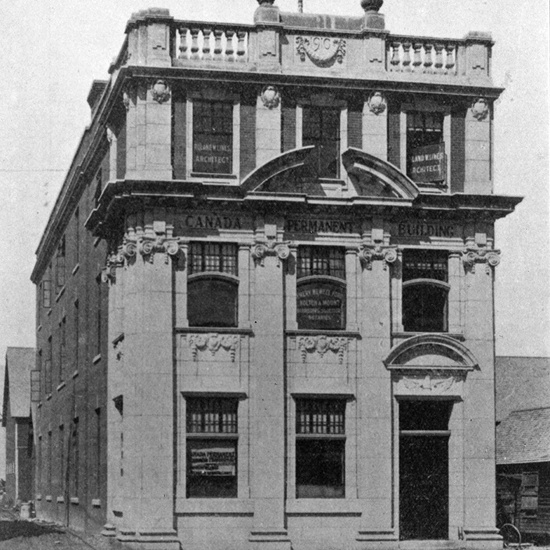Canada Permanent Building
This small jewel of a building holds its own nestled among downtown high-rises.
This small jewel of a building holds its own nestled among downtown high-rises.
Although better known to recent generations of Edmontonians as the original location of the Japanese Village restaurant, which occupied the building from 1974-2012, the Canada Permanent Building started its life as the provincial headquarters of the Canada Permanent Mortgage Company.
Designed by Roland Lines and built by contractors Pheasey & Batson for $65,000 in 1910, the Canada Permanent Building is a three-storey rectangular structure framed in reinforced concrete and faced with red brick and stone. An excellent example of the Edwardian Baroque style, it features extensive classical detailing on the three-bay front façade, which is faced with ashlar cut stone and includes prominent rectangular and arched windows with multi-paned transoms.
The flat roof is edged with a stone balustrade featuring a carved central date stone decorated with an Adamesque swag garland with tassels and topped by urns. Ionic pilasters the height of the first two storeys outline the bays and support a second-storey entablature, including a heavy cornice decorated with modillions and a broken segmental arched pediments.
The front entrance is offset to the north, in the third bay of the front façade, and is surmounted at the first floor by a segmental arched pediment decorated with a carving of a winged lighthouse, the symbol of the Canada Permanent Mortgage Company. The ornamental carved spandrels between the first-and second-storey windows of the other two bays provide a conterpoint to the detail of the front entrance.
Tha Canada Permanent Building, along with the neighbouring McLeod Building, was slated for demolition in 1980, but a public outcry led to the purchase of both buildings by the provincial government. It was designated a Provincial Historic Resource in 1995.
Details
Type
Commercial
Designation Status
Provincial Historic Resource
Neighbourhood
Time Period
Year Built
1910
Architects
Architectural Styles
Character Defining Elements
Balustrade , Brick structure , Carving , Cornice , Date stone , Entablature , Flat roof , Pediment , Pilaster , Rectangular footprint , Stone cladding , Three storeys or more , Reinforced concrete structure

